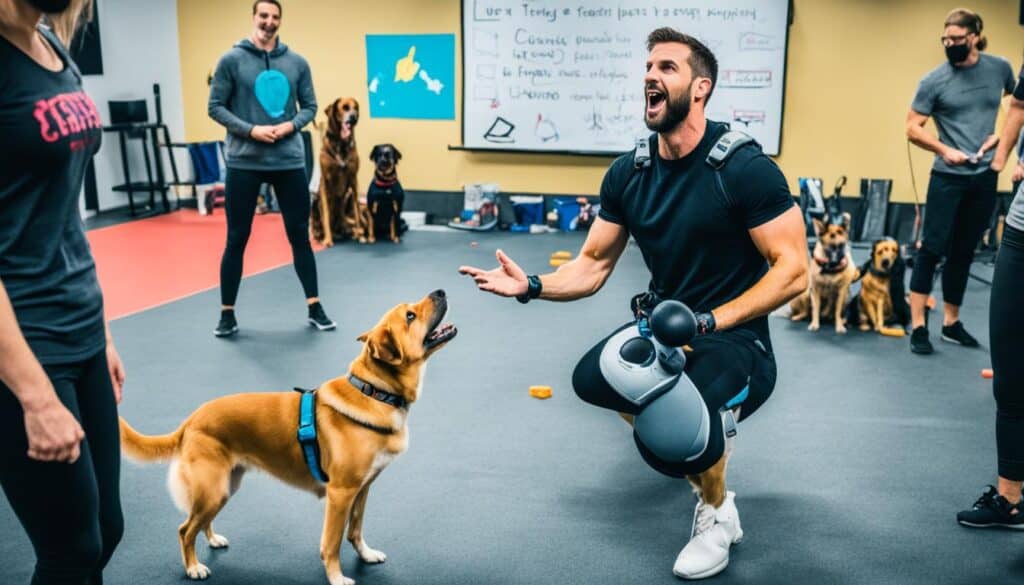Positive reinforcement is a popular and effective method of training dogs aimed at positively modifying their behavior. However, like any training approach, it has its challenges. Dog trainers may encounter various obstacles when implementing positive reinforcement techniques. Trainers must understand and address these challenges to ensure successful training outcomes for their canine companions.
This section will explore the common challenges and issues faced in positive reinforcement training. From difficulties in balancing treats and corrections to the unique training challenges presented by stubborn and reactive dogs, we will uncover the key obstacles that trainers may encounter. We will also discuss the importance of implementing positive reinforcement effectively and overcoming resistance to this training method.

Key Takeaways:
- Positive reinforcement training in dogs can present various challenges.
- Issues may arise in balancing threats and corrections.
- Training stubborn dogs with positive reinforcement can be challenging.
- Reactive dogs may pose unique training difficulties.
- Understanding and implementing positive reinforcement effectively is crucial.
What is Positive Reinforcement Training in Dog Training?
Positive reinforcement training is a highly effective method widely used in dog training. It involves rewarding desired behaviors to encourage their repetition. When a dog performs a behavior that is desired or taught by the trainer, such as sitting or staying, they are immediately rewarded with something they find pleasant, such as treats, praise, or playtime. The idea behind positive reinforcement is that by associating these rewards with the desired behaviors, dogs are motivated to repeat those behaviors in the future.
This training method is based on the principle that rewards increase the likelihood of a behavior being repeated. In contrast, punishment or aversive methods decrease the probability of a behavior being repeated. Positive reinforcement focuses on encouraging and reinforcing desired behaviors rather than punishing or correcting undesirable ones, making it a gentle and humane approach to dog training.
Comparing Positive and Negative Reinforcement: What Works?
Positive reinforcement training stands in contrast to negative reinforcement, which involves removing an aversive stimulus when a desired behavior is performed. While both methods can be effective in modifying behavior, positive reinforcement has several advantages over negative reinforcement.
- Reward-based training: Positive reinforcement is rooted in rewarding desired behaviors, which helps create a positive and enjoyable training experience for the dog.
- Humane and ethical: Positive reinforcement focuses on teaching and reinforcing desired behaviors rather than punishing or correcting unwanted ones, making it a humane and ethical approach.
- Lasting results: Positive reinforcement has been shown to have long-lasting effects on behavior. Dogs trained using positive reinforcement tend to retain the learned behaviors and display them even without rewards.
- Improved relationship: Positive reinforcement training strengthens the bond between the dog and the trainer, relying on trust, cooperation, and mutual understanding.
While negative reinforcement can also be effective in certain situations, positive reinforcement training is generally preferred because it focuses on positive experiences and builds a solid foundation of desired behaviors.
| Positive Reinforcement | Negative Reinforcement |
| Focuses on rewarding desired behaviors | Focuses on removing aversive stimuli |
| Creates a positive training experience | Relies on the aversion of undesirable stimuli |
| Builds a strong bond and trust between dog and trainer | Relies on the avoidance of negative consequences |

Why Might Positive Reinforcement Dog Training Sometimes Fail?
While positive reinforcement is a widely effective training method, there are several reasons why it may fail in certain situations. This section will explore the common challenges and obstacles that trainers may encounter when using positive reinforcement. Topics to be covered include:
- Inconsistent timing.
- Incorrect reward value.
- Competing motivators.
- Owner’s skill and frustration.
- Lack of structure.
- Individual dog differences.
- Misunderstanding of positive reinforcement.
- Inadvertently reinforcing negative behaviors.
By understanding these potential pitfalls, trainers can take steps to overcome them and enhance the effectiveness of positive reinforcement training.
Inconsistent Timing
Inconsistent timing is one of the key reasons why positive reinforcement training may fail. Dogs learn through association, so delivering rewards immediately after the desired behavior is essential to reinforce the connection between the behavior and the reward. If the timing is inconsistent, the dog may not understand which behavior is rewarded, leading to confusion and ineffective training.
Incorrect Reward Value
Another challenge in positive reinforcement training is determining the appropriate reward value. Different dogs have different motivators and preferences, so it’s crucial to find highly motivating rewards for each dog. Using rewards that are not valuable enough may not be sufficient to reinforce the desired behavior, leading to training failures.
Competing Motivators
Dogs are motivated by various factors, such as food, play, and attention. In positive reinforcement training, it’s essential to consider and address any competing motivators that may distract the dog from the desired behavior. If the dog is more interested in other rewards or stimuli, effectively reinforcing the desired behavior can be challenging.
Owner’s Skill and Frustration
The skill and consistency of the owner/trainer play a significant role in the success of positive reinforcement training. Suppose the owner needs to gain the necessary knowledge and experience or become frustrated and inconsistent in their approach. In that case, it can hinder the dog’s learning process and create obstacles in training.
Lack of Structure
Positive reinforcement training requires a structured approach to ensure clear communication and consistent expectations. With a structured training plan, the dog may understand what is expected of them. A lack of structure can lead to ineffective training and hinder progress.
Individual Dog Differences
Every dog has a unique personality, temperament, and learning style. What works for one dog may only work for one dog. Understanding and adapting to these individual differences is crucial in positive reinforcement training. Failure to do so can lead to ineffective training methods for specific dogs.
Misunderstanding ‘Positive Reinforcement’
There can be misunderstandings or misinterpretations of the concept of positive reinforcement itself. Some trainers may inadvertently reinforce undesired behaviors, thinking they use positive reinforcement. It’s essential to clearly understand what positive reinforcement entails and use it correctly to avoid inadvertently reinforcing negative behaviors.
Reinforcing Negative Behaviors
In positive reinforcement training, there is a risk of inadvertently reinforcing negative behaviors if the trainer fails to identify and address them appropriately. This can occur when the trainer unintentionally rewards or reinforces behaviors that should be discouraged, leading to confusion and setbacks in the training process.
Limitations of Positive Reinforcement
While positive reinforcement is a valuable training method, it does have its limitations. Trainers must be aware of these limitations to effectively navigate the challenges that may arise during the training process.
Time-Intensive
Positive reinforcement training can be time-intensive, especially when dealing with complex behaviors or training multiple dogs. It requires patience, consistency, and dedication from the trainer and the dog owner. The process of reinforcing desired behaviors through rewards and shaping can take time and may require repeated practice sessions.
Situational Challenges
Positive reinforcement training may face situational challenges in highly distracting or chaotic environments. Distractions such as other dogs, loud noises, or crowded spaces can make it difficult for the dog to focus on the desired behavior and receive appropriate reinforcement. Trainers must identify and manage these challenges to ensure adequate training.
Necessity of Ongoing Reinforcement
Positive reinforcement training involves ongoing reinforcement to ensure the maintenance of desired behaviors. Dogs need consistent rewards and reinforcement to continue exhibiting the desired behaviors over time. Trainers must create a structured training plan that includes regular reinforcement sessions and reinforces the learned behaviors in various contexts.
Not Ideal for Urgent Safety Issues
Positive reinforcement training may not be suitable for urgent safety issues requiring immediate action. When a dog’s safety is compromised, or there is an immediate danger, it may be necessary to implement more direct and immediate training methods to protect the dog and others from harm.
To address the limitations of positive reinforcement training, trainers can complement this method with other training techniques and strategies. By understanding and adapting to these limitations, trainers can create more effective training plans and support dogs’ overall well-being and behavior modification.

When to Seek Professional Help: The Role of a Dog Trainer
In some cases, dog owners may encounter challenging behaviors or complex training issues that require professional help. Recognizing the signs that indicate the need for skilled, positive reinforcement training is crucial for addressing these training challenges effectively. Additionally, choosing the right dog trainer and understanding the importance of working with a professional for severe behavioral issues are essential to successful training outcomes.
Signs Your Dog May Need a Professional Positive Reinforcement Trainer
Several signs may indicate the need for professional help in dog training:
- Consistent inability to modify or manage specific problem behaviors
- Aggression or fear-related behaviors that pose a threat to safety
- Persistent anxiety or separation-related issues
- Extreme reactivity towards other dogs or humans
- Unresponsiveness to basic commands
Seeking professional assistance is crucial when these signs are present to ensure the well-being of both the dog and the owner.
How to Choose the Right Dog Trainer for Positive Reinforcement Training
When seeking professional help for dog training, choosing a trainer specializing in positive reinforcement techniques is essential. Consider the following factors:
- Qualifications and certifications of the trainer
- Experience in working with similar behavioral issues
- Positive reputation and testimonials from previous clients
- Alignment with your training goals and values
- The trainer’s ability to establish trust and build a positive rapport with your dog
The Importance of Working with a Professional for Severe Behavioral Issues
In cases of severe behavioral issues, working with a professional is crucial to address these challenges effectively.
A professional, positive reinforcement trainer has the knowledge and expertise to identify the root causes of severe behavioral issues and implement appropriate training techniques. This ensures the safety and well-being of the dog and those around them.
Moreover, a professional trainer can guide and support the dog owner, offering strategies and tools to manage the dog’s behavior and establish a harmonious relationship.
Seeking professional help for dog training is essential to resolving complex training issues and ensuring a happy and well-behaved canine companion. By recognizing the signs that indicate the need for professional, positive reinforcement training, choosing the right trainer, and addressing severe behavioral issues with expert guidance, dog owners can set their dogs up for training success and foster a positive and fulfilling relationship.
Conclusion
Positive reinforcement training is widely recognized as a highly effective method for modifying dog behavior. However, it is essential to acknowledge the challenges associated with this approach.
Understanding and addressing the obstacles that trainers may encounter when implementing positive reinforcement techniques is crucial for success. Inconsistent timing, incorrect reward value, competing motivators, owner’s skill and frustration, lack of structure, individual dog differences, misunderstanding of positive reinforcement, and reinforcing negative behaviors can all hinder progress.
By recognizing and adapting to these challenges, trainers can overcome them and achieve successful results with positive reinforcement. Additionally, it is essential to note that seeking professional help when needed can be instrumental in addressing severe behavioral issues and ensuring the well-being of our canine companions.
In conclusion, while positive reinforcement training offers significant benefits, it requires understanding its challenges and limitations. By being aware of these factors and adapting training methods accordingly, trainers can navigate the complexities of positive reinforcement and create positive changes in dog behavior.

